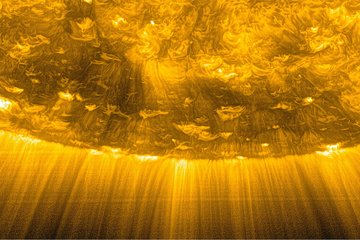All genres
241.
Talk
Effects of solar irradiance on the upper ionosphere and ion fluxes at Mars, Mars Express and MAVEN observations. 8th MUAN meeting, Leicester, UK (2016)
242.
Talk
The evolution of water reservoirs on the terrestrial planets. Space Plasma Seminar, Sao Jose dos Campos, Brazil (2016)
243.
Talk
BepiColombo - an ESA/JAXA mission to explore Mercury. Space Plasma Seminar, Sao Jose dos Campos, Brazil (2016)
244.
Talk
JUICE: a European mission to Jupiter and its icy moons. Space Plasma Seminar, Sao Jose dos Campos, Brazil (2016)
245.
Talk
Feasibility study of the in-situ detectability of Europa's neutral and plasma plumes from a flyby mission. Europa-Enceladus Plumes Workshop, Pasadene, Caltech, USA (2016)
246.
Talk
Coherent large-amplitude waves in the Martian plasma environment. 1st URSI Atlantic Radio Science Conference, Gran Canaria, Spain (2015)
247.
Talk
Cold Ion Escape from the Martian Ionosphere. European Planetary Science Congress, Nantes, France (2015)
248.
Talk
Phobos-solar wind interaction: Results from Mars Express for the closest-ever fly-by. European Geosciences Union General Assembly 2014, Vienna, Austria (2014)
249.
Talk
Large-amplitude coherent structures in plasma near Mars. The 5th Moscow Solar System Symposium (5M-S3), Moscow, Russia (2014)
250.
Talk
Ionospheric magnetic fields and currents at Venus and Mars. European Geosciences Union General Assembly 2014, Vienna, Austria (2014)
251.
Talk
Ionospheric magnetic fields at Venus and Mars and their effect on plasma flow in the near planet wakes. EPSC, Estoril, Portugal (2014)
252.
Talk
Asymmetrical response of the ionospheric magnetization and the plasma sheet formation on the IMF orientation. 6th Alfven Conference: Plasma Interactions with Solar System Objects anticipating Rosetta, MAVEN and Mars Orbiter Mission, London, UK (2014)
253.
Talk
Plasma Energization in the Jovian System. European Planetary Science Congress EPSC, Cascais, Portugal (2014)
254.
Talk
Global Flow Patterns in the Jovian Magnetosphere: Galileo/EPD and Galileo/PLS measurements. European Planetary Science Congress EPSC, Cascais, Portugal (2014)
255.
Talk
Ablation of Venusian oxygen ions by unshocked solar wind. European Geosciences Union General Assembly 2014, Vienna, Austria (2014)
256.
Poster
Study of Mars' crustal magnetic field displacements due to its interaction with the solar wind. EPSC-DPS Joint Meeting 2019, Geneva, Switzerland (2019)
257.
Poster
Efficiency of Solar wind electric field in accelerating planetary ions. EPSC-DPS Joint Meeting 2019, Geneva, Switzerland (2019)
258.
Poster
Mars in the Solar Wind - Simulations and Observations. EPSC-DPS Joint Meeting 2019, Geneva, Switzerland (2019)
259.
Poster
CO2+ ion escape from Mars. EPSC-DPS Joint Meeting 2019, Geneva, Switzerland (2019)
260.
Poster
Reduced Atmospheric Ion Escape Above Martian Crustal Magnetic Fields. 21st EGU General Assembly, EGU2019, Vienna, Austria (2019)










